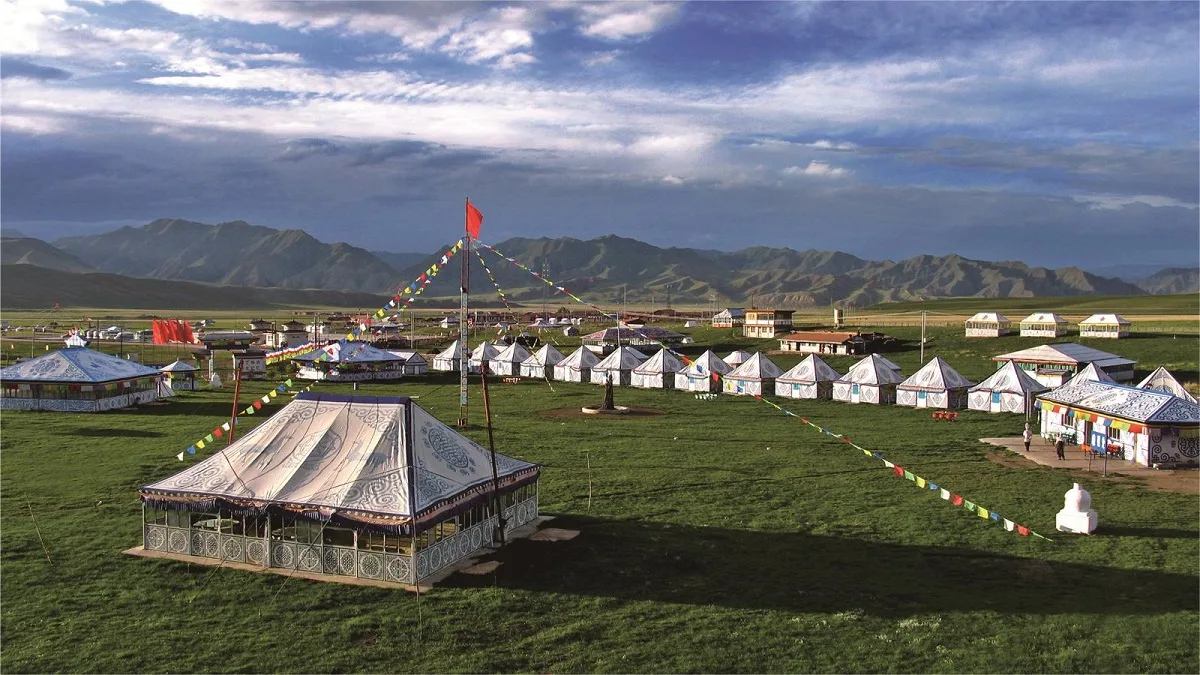Ganjia Grasslands (甘加草原), located in Gannan Tibetan Autonomous Prefecture, is a picturesque alpine meadow characterized by its expansive vistas and rich cultural significance. Situated at an average altitude of over 3000 meters, it serves as a vital pastoral base for the local Tibetan communities. The grasslands stretch endlessly, offering a rare and precious natural tourism destination.
During the summer months, Ganjia Grasslands transform into a lush green expanse, resembling a natural carpet dotted with vibrant wildflowers. The scene is complemented by the seamless blend of blue skies, white clouds, and verdant grasslands, while the meandering Yangqu and Yangla Rivers add to the landscape’s serene beauty, akin to pure white Tibetan scarves (khada) gently laid across the plains.
Since June 2018, Ganjia Grasslands has offered a unique tourism experience with the establishment of the Muyun Tent Camp. This campsite features 11 tents, including one used as an exhibition hall and the remaining ten for guest accommodation. The tents are equipped with both single and double beds, divided into four large and six small tents. The campsite provides a variety of services, including Tibetan and Sichuan cuisine, traditional roasted whole lamb, horseback riding, temple visits for blessings, and evening bonfire gatherings, allowing visitors to immerse themselves fully in the spirit of the vast grasslands.
Table of Contents
- Basic Information
- Location and Transportation
- Highlights of Ganjia Grasslands
- Vlog about Ganjia Grasslands
- Other Attractions in Xiahe County
Basic Information
| Estimated Length of Tour | 2 – 3 hours |
| Ticket Price | Free |
| Opening Hours | 24 hours a day throughout the year |
Location and Transportation
Ganjia Grasslands are situated in Ganjia Township, Xiahe County, Gannan Tibetan Autonomous Prefecture, Gansu Province, China. Located 33 kilometers north of Xiahe County, the grasslands are easily accessible by road.
From Xiahe, it takes about 30-40 minutes by car to reach Ganjia Grasslands. For travelers coming from Lanzhou, the capital city of Gansu Province, buses are available to Xiahe for approximately 75 RMB, followed by a taxi ride to Ganjia Grasslands costing about 25 RMB per vehicle. Additionally, Xiahe Airport offers shuttle services directly to Ganjia Grasslands at a cost of 200 RMB per trip for a 7-seat minivan.
Highlights of Ganjia Grasslands
Bai Shi Ya Monastery (白石崖寺院)

Bai Shi Ya Monastery (White Stone Cliff Monastery), also known as Bai Shi Ya Gompa, holds a significant place in the cultural and religious landscape of Ganjia Grasslands. Founded in the 14th century by Lama Dawa Sangpo, the disciple of Tsongkhapa, it initially attracted thousands of monks, becoming a center of Buddhist learning and practice. Over the centuries, the monastery underwent several reconstructions and expansions, culminating in its major restoration in 1705 under the leadership of Ganjia Banzhida. In 1711, the monastery established the Wen Si Academy for philosophical studies, which later evolved into a Tibetan Buddhist tantric college in 1752 under the patronage of Gongtang II.
In 1783, Bai Shi Ya Monastery came under the authority of the 2nd Jampal Gyatso Rinpoche of Labrang Monastery, solidifying its affiliation as a dependent monastery. Today, it hosts over a hundred monks dedicated to the study and practice of Vajrayana Buddhism. The monastery is renowned for its strict adherence to Buddhist precepts, intensive rituals, and the worship of fundamental deities such as Amitabha, Manjushri, and Avalokiteshvara. Monastic life here revolves around profound spiritual practices, scholarly pursuits in Tibetan literature, rhetoric, medicine, astronomy, and maintaining peace through meditation retreats in places like Taishishan.
Octagonal Ancient City (八角古城)

Located 35 kilometers north of Xiahe County on the plateau where the Yangqu and Yangla Rivers converge, the Octagonal Ancient City is an archaeological marvel and a historical testament to the strategic importance of Ganjia Grasslands. This ancient city played a crucial role as a military stronghold and a pivotal point in the ancient trade routes between Gansu and Qinghai provinces. Throughout history, it witnessed conflicts and exchanges between various central Chinese dynasties and regional powers like the Tubo, Western Xia, and Salar empires.
Archaeological surveys have unearthed artifacts spanning from the Northern and Southern Dynasties to the Sui, Tang, Song, Yuan, Ming, and Qing dynasties, providing insights into the rise and fall of the Silk Road’s Henan Route. The city derives its name from its unique octagonal shape, resembling a hollow cross in layout, known locally as “Kareng” in Tibetan or “Kar Yongzhong” in Tibetan historical texts, meaning the “City of Ten Thousand Characters.”





